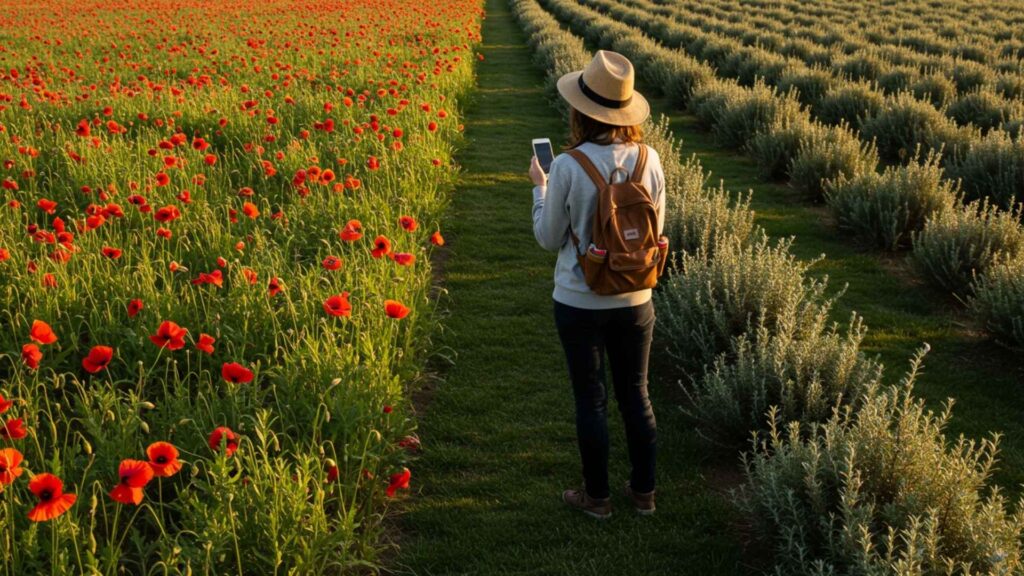Anzac Day and Remembrance Day: 5 Surprise Differences

Wait… Aren’t They the Same Thing?
Suppose you’ve ever traveled to Australia or New Zealand – or even just explored their rich cultural traditions. In that case, you may have wondered about the difference between Anzac Day and Remembrance Day.
These two national days of tribute may seem similar at first glance. Still, despite their shared reverence, they commemorate very different events, meanings, and historical contexts. People often confuse them, and that’s understandable!
So, this guide will walk you through the difference between Anzac Day and Remembrance Day in detail.
What Is Anzac Day?
Before we explore the specific difference between Anzac Day and Remembrance Day, it’s important to understand exactly what Anzac Day stands for.
Date: April 25
Anzac Day is one of the most significant national holidays in both Australia and New Zealand. Observed every year on April 25, Anzac Day marks the anniversary of the Gallipoli landing of the Australian and New Zealand Army Corps (ANZAC) during World War I in 1915.
The Origin and The Significance
The origin of Anzac Day lies in the ill-fated Gallipoli Campaign, where the ANZACs landed on the shores of Turkey in 1915. Despite suffering heavy losses, the campaign became a defining moment in the national consciousness, forging a deep sense of identity and mateship for both countries.
Anzac Day is a solemn tribute to those ANZAC soldiers who fought and fell at Gallipoli, and its significance continues to resonate with each passing generation as a powerful symbol of courage, sacrifice, and unity.
The phrase “Lest We Forget” carries tremendous meaning today, reminding everyone of the cost of freedom.

Traditions and Ceremonies
The Dawn Service is the most iconic tradition, typically starting around 5.30 am to 6 am to symbolize the time of the original landing in Gallipoli. People gather in silence, listen to readings such as “The Ode” poem, and pay respects during a minute of reflection. Other traditions include:
- Wearing rosemary sprigs, believed to aid memory, and found growing on Gallipoli.
- Red poppies are also used as a remarkable symbol on this day.
- Anzac Day parades with veterans and active service members marching.
- Baking Anzac biscuits, a wartime staple sent to soldiers.
- Wreath-laying ceremonies at war memorials and cenotaphs.
These ceremonies connect people to history and bring communities together in a shared moment of remembrance.
What Is Remembrance Day?
After exploring the meaning of Anzac Day, it’s just as important to understand the role and reach of Remembrance Day.
Date: November 11
Held on November 11, Remembrance Day marks the exact moment – 11 AM on the 11th day of the 11th month – when World War I officially ended in 1918.
Original name: The Armistice Day
Initially known as Armistice Day, this commemoration began in 1919 to honor the signing of the armistice agreement that ended World War I. Over time, it expanded in meaning to recognize those who served and died in all subsequent wars and peacekeeping missions.
Today, Remembrance Day is observed in many Commonwealth countries, including Australia, New Zealand, Canada, and the UK, each adding its touch of cultural tradition.
Significance
Unlike Anzac Day, which specifically honors the ANZAC troops, Remembrance Day is universal – a moment for reflection on the global toll of warfare. It symbolizes the end of one of the world’s most devastating conflicts and the ongoing hope for peace.
In contrast with the rosemary on Anzac Day, people will wear the red poppy, inspired by the famous poem In Flanders Fields, as a global symbol of remembrance.
Traditions
- The famous 1-minute silence at 11:00 AM.
- Wearing only one kind of flower are red poppies on the lapels, is a sign of tribute.
- Reciting poems like “In Flanders Fields”.
- Attending community services held in schools, town centers, and war memorials.

Though often quieter and more local than Anzac Day, these ceremonies are deeply moving and carry a powerful sense of respect and gratitude.
Key Difference Between Anzac Day and Remembrance Day
Now that you understand what each day represents, a side-by-side comparison is helpful to see the key difference between Anzac Day and Remembrance Day.
| Aspect | Anzac Day | Remembrance Day |
| Date | Annual April 25 | Annual November 11 |
| Observed In | Australia, New Zealand, Gallipoli | Australia, New Zealand, Canada, the UK, France, Belgium, South Africa, India, Germany, and other Commonwealth & allied nations |
| Historical Origin | Gallipoli Campaign, WWI (1915) | Armistice ending WWI (1918) |
| Who is Remembered? | Honoring the Australian and New Zealand Army Corps (ANZAC) | Honoring all who have died in service, including all wars and conflicts |
| Symbols & Traditions | Dawn services, rosemary, Anzac biscuits, The Ode poem | Red poppies, 1-minute silence at 11 AM, “In Flanders Fields” poem |
| Timing and Season | Anzac Day in autumn (April) | Remembrance Day in spring (November) |
| Scope of Observance | Primarily Australia & New Zealand | Widely observed across Commonwealth & Allied nations |
As this comparison illustrates, the distinction between Anzac Day and Remembrance Day extends beyond the dates. The unique histories, cultural ties, and emotional tones shape how each is observed, helping you plan gifts for each day easily with top gift ideas for Anzac Day 2025.
Why Does it Matter to Know the Difference?
If you’re visiting during either of these commemorations, understanding their meanings can enrich your experience.
- You’ll avoid awkward moments like asking the wrong questions.
- You’ll connect better with locals who hold these days close to heart.
- If you’re researching national identity, these events are gold mines for insights into collective memory and values.

How to Respectfully Participate as a Visitor
- Arrive early: Give yourself time to find a respectful spot and settle in before the ceremony begins.
- Dress Code: Wear modest, respectful clothing – dark colors are best.
- Wear a poppy or sprig of rosemary: These traditional symbols of remembrance are worn over the heart.
- Stand and remove headwear: During formal service parts, such as the anthem or The Ode, it is customary to stand and remove hats.
- Behavior Tips: Stay quiet and attentive during services. Don’t talk or use your phone.
- What (Not) to Say: Avoid asking “Is this like Memorial Day?” or “Who won?”. Focus instead on listening and learning.
- Photography Etiquette: Photos are usually okay before or after the ceremony. Never snap pics during the silence or personal moments.

Recommended Places to Visit for Each Day
Looking to experience these commemorative days firsthand? Here are the top places to witness the meaning of Anzac Day and Remembrance Day come to life.
Anzac Day Must-Visit Spots
- Gallipoli, Turkey: The most powerful and authentic experience. Pilgrims gather for the dawn service at the original landing site.
- Australian War Memorial, Canberra: Hosts the nation’s largest ceremony with a formal Dawn Service and national broadcast.
- Auckland War Memorial Museum, New Zealand: Blends Māori and military traditions in inclusive commemorations.
- Kings Park, Perth: Scenic hilltop views and one of Australia’s most attended Dawn Services.
- Shrine of Remembrance, Melbourne: Features dawn gatherings, educational tours, and interactive exhibits.

Remembrance Day Must-Visit Spots
- Australian War Memorial, Canberra: A poignant ceremony with wreath-laying and a moment of silence at 11 AM.
- Auckland Domain, New Zealand: A peaceful park offering intimate, community-led tributes.
- Commonwealth War Graves Worldwide: Sites in France, Belgium, and more hold quiet ceremonies and vigils.
- Shrine of Remembrance, Melbourne: Offers exhibits and reflective programs ideal for individuals and families.

The Last Word
Understanding the difference between Anzac Day and Remembrance Day isn’t just about dates or ceremonies – it’s about appreciating two unique narratives of bravery, sacrifice, and national identity. While both days are deeply emotional and culturally significant in Australia and New Zealand, they each honor different chapters of military history with their tone and traditions.
If you’re lucky enough to visit during these commemorations, take the opportunity to connect more deeply with the culture, the people, and the stories that shaped them. Whether you attend on which Day, the experience will be unforgettable – and undeniably meaningful.
FAQs
1. Can tourists attend Anzac Day ceremonies?
Yes, absolutely. Just be respectful and follow local customs.
2. Is Remembrance Day a public holiday?
Not in most areas, though some businesses may pause briefly for the silence.
3. Are there local tours or guides during these commemorations?
Yes, especially in Gallipoli, Canberra, and Wellington.
4. What should I wear?
Something dark and conservative. Avoid flashy or casual clothing.
5. Which flower should I wear for Anzac Day and Remembrance Day?
Wear rosemary on Anzac Day and poppy flowers on Remembrance Day.

I am a cultural historian and editor with over 10 years of research into pre-contact Polynesian history, the Lapita migration, and oral traditions. Share the excitement of my latest publications.
My contact:
Email: [email protected]
Tel: +64 21 456 7890







